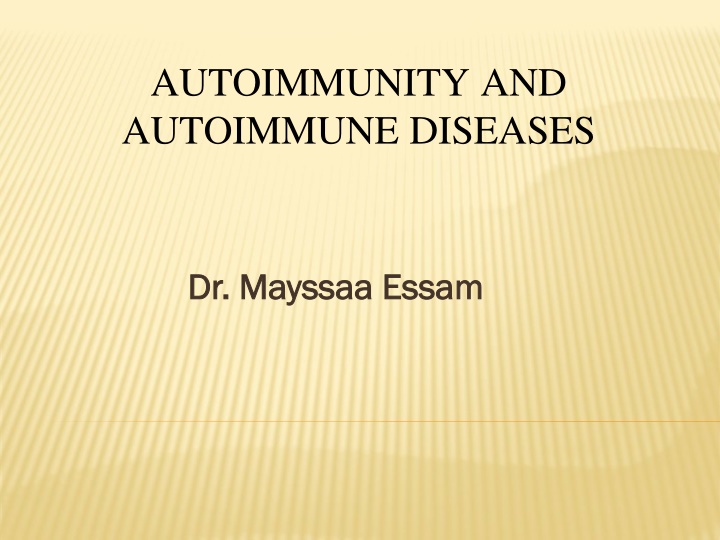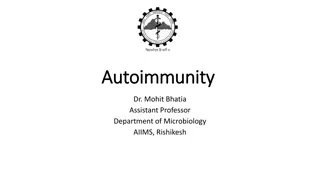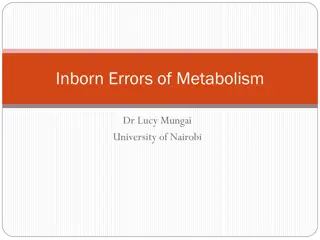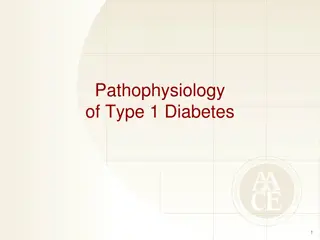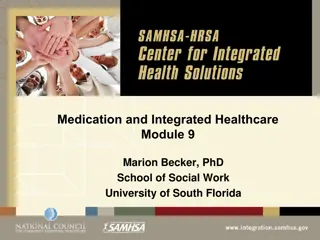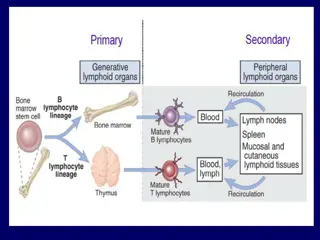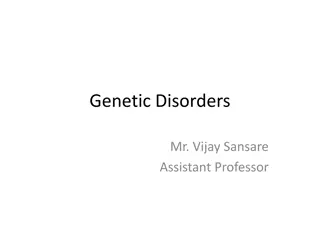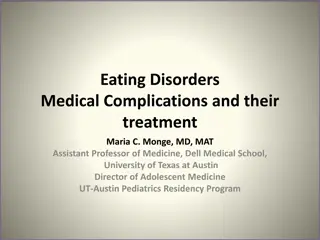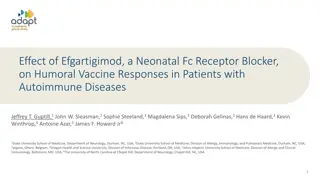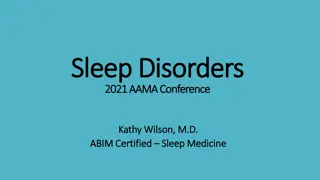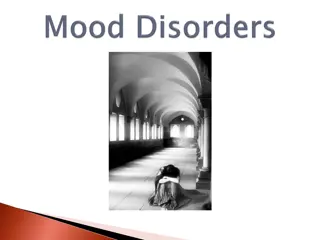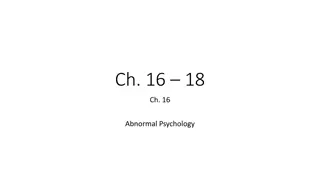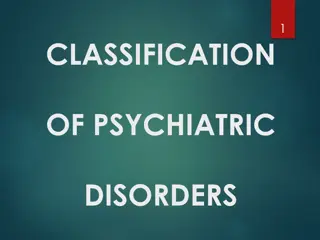Autoimmunity and Autoimmune Disorders
Autoimmunity refers to the immune system's failure to recognize its own cells, leading to attacks on self-tissues. Autoimmune disorders encompass over 80 chronic illnesses where the immune system mistakenly targets organs. These disorders are poorly understood and recognized, impacting various organs and systems. Specific autoantibodies and immune responses play roles in the pathogenesis and manifestations of autoimmune diseases.
Download Presentation

Please find below an Image/Link to download the presentation.
The content on the website is provided AS IS for your information and personal use only. It may not be sold, licensed, or shared on other websites without obtaining consent from the author.If you encounter any issues during the download, it is possible that the publisher has removed the file from their server.
You are allowed to download the files provided on this website for personal or commercial use, subject to the condition that they are used lawfully. All files are the property of their respective owners.
The content on the website is provided AS IS for your information and personal use only. It may not be sold, licensed, or shared on other websites without obtaining consent from the author.
E N D
Presentation Transcript
AUTOIMMUNITY AND AUTOIMMUNE DISEASES Dr. Dr. Mayssaa Mayssaa Essam Essam
AUTOIMMUNITY The term autoimmunity refers to a failure of the body s immune system to recognize its own cells and tissues as self , Instead immune responses are launched against these cells and tissues as if they were foreign or invading bodies. It occurs when mechanism of self-tolerance fail.
AUTOIMMUNE DISORDER Autoimmune disorder refers to a varied group of more than 80 serious, chronic illnesses that involve almost every human organ system. In all these disorders, the underlying problem is similar; the body s immune system becomes misdirected, attacking the organs it was designed to protect. Autoimmune disorders remain among the most poorly understood and poorly recognized of any category of illnesses. Individually, autoimmune disorders occur infrequently, except for thyroid disease, diabetes, rheumatoid arthritis, and systemic lupus erythematosus. Overall, autoimmune disorders represent the fourth largest cause of disability in Europe and the United States.
The term autoimmune disorder is used when demonstrable immunoglobulins (autoantibodies) or cytotoxic T cells display specificity for self antigens, or autoantigens, and contribute to the pathogenesis of the disorder (Table 1-1). Autoimmune disorders are characterized by the persistent activation of immunologic effector mechanisms that alter the function and integrity of individual cells and organs. The sites of organ or tissue damage depend on the location of the immune reaction. The variety of signs and symptoms seen in patients with autoimmune disorders reflects the various forms of the immune response. .
It is also important to note that autoantibodies may be formed in patients secondary to tissue damage or when no evidence of clinical disease exists. Unlike autoimmune disorders, autoantibodies can occur as immune correlates of conditions such as blood transfusion reactions. In addition, autoantibodies can be demonstrated in hemolytic disease of the newborn can result from disorders such as serum sickness, anaphylaxis, and hay fever when the immune response is clearly the cause of the disease. (Table 1-2).
Table Table Diseases Diseases Active chronic hepatitis Addison s disease Autoimmune atrophic gastritis Autoimmune hemolytic anemia Dermatomyositis Discoid lupus erythematosus Hashimoto s thyroiditis Idiopathic thrombocytopenic purpura Insulin-dependent (juvenile, type 1) diabetes mellitus Multiple sclerosis Pemphigus vulgaris Pernicious anemia Primary biliary cirrhosis Rheumatoid arthritis Scleroderma Systemic lupus erythematosus Thyrotoxicosis 1 1- -1 1 Examples of Autoimmune Examples of Autoimmune
Table1 Table1- -2 Antigens Implicated in Autoimmune Endocrine 2 Antigens Implicated in Autoimmune Endocrine Diseases Diseases Disorder Disorder Antigen Hashimoto s disease Thyroid peroxidase Thyroglobulin Thyrotropin receptor Antigen Graves disease Thyrotropin receptor Thyroid peroxidase Thyroglobulin Type 1 diabetes Insulin/proinsulin Insulin receptor Glutamic acid decarboxylase Addison s disease Adrenal cortical cells Idiopathic Endothelial antigen hypoparathyroidism Mitochondrial antigen
AUTOIMMUNE AUTOIMMUNE In autoimmune hemolytic anemia, antibodies specific for blood group antigens (including Rh) expressed on the surface of RBCs are responsible for destroying these RBCs. This results in anemia, a reduced number of RBCs or decreased hemoglobin level in the circulation. The destruction of the red cells can be attributed to several mechanisms:- One involves the activation of the complement cascade and lysis of the cells. The result release of hemoglobin may lead to its appearance in the urine (hemoglobinuria). HEMOLYTIC HEMOLYTIC ANEMIA ANEMIA
The second mechanism is the opsonization of RBCs facilitated by antibody and the C3b component of complement .In the latter case, the RBCs are bound to and engulfed by macrophages with receptors for Fc and C3b that attach to the antibody-coated RBCs. A third mechanism is the destruction of RBCs through antibody-dependent cellular cytotoxicity (ADCC), mediated by NK cells and other effector cells .This mechanism does not require complement.
Antibodies responsible for autoimmune hemolytic anemia are customarily divided into two groups on the basis of their physical properties:- The first group consists of the warm autoantibodies, so called because they react optimally with RBCs at 37 C. The warm autoantibodies are primarily IgG, and some react with Rh antigens expressed on the surface of the RBCs. IgG antibodies to these antigens are effective in inducing immune adherence to macrophages and facilitating phagocytosis.
A second type of antibody, the cold agglutinins, attach to RBCs only when the temperature is below 37 C and dissociate from the cells when the temperature rises above 37 C. Cold agglutinins are primarily IgM and are specific for I antigen expressed on the surface of RBCs, because the cold agglutinins are IgM, they are highly efficient at activating the complement cascade and causing lysis of the attached erythrocytes.
NOTE Body temperature is maintained at 37 C, hemolysis resulting from cold agglutinins is not severe in patients with autoimmune hemolytic anemia. However, when the arms, legs, or skin are exposed to cold and the temperature of the circulating blood is allowed to drop, severe attacks of hemolysis may occur. Sometimes, cold agglutinins appear after infection by some viruses or Mycoplasma pneumoniae, implicating an infectious disease trigger in genetically susceptible individuals.
GRAVES GRAVES DISEASE DISEASE. Is a hyperactive thyroid gland (hyperthyroidism). The disease most commonly affects women in their 30s and 40s; the female to male ratio is about 8 : 1. Graves disease is an example of an autoimmune disease in which antibodies directed against a hormone receptor act as agonists and activate rather than interfere with the activity of the receptor.
patients with this disease develop autoantibodies against receptors for thyroid- stimulating hormone (TSH) that are expressed on the surface of thyroid cells. Figure (1-1) shows that the interaction of autoantibodies with the TSH receptor activates the cell in a manner similar to TSH activation, thereby stimulating excess production of thyroid hormone. Normally, TSH produced by the pituitary binds to TSH receptors on the thyroid, activating the gland to produce and secrete thyroid hormones.
When the level of thyroid hormones gets too high, the production of TSH and thus the production of thyroid hormones is shut down via a negativefeedback loop. Graves disease the autoantibodies continuously stimulate the TSH receptors, resulting in excessive production of thyroid hormone, which leads to hyperthyroidism.
Figure (1-1) In Graves disease, antibody to the TSH receptor acts as a receptor agonist and induces chronic stimulation of the thyroid to release thyroid hormones.
SIGNS & SYMPTOMS SIGNS & SYMPTOMS Increase in metabolism. Heart palpitations, Heat intolerance, Insomnia, Nervousness, Weight loss, Hair loss,Fatigue. In addition, patients with severe disease may develop eye problems, including inflammation of the soft tissue surrounding the eye, bulging of the eye, and double vision. Some patients with Graves disease develop an enlarged thyroid gland known as a goiter,Figure (1-2).
REFRENCES - Oxford Handbook of Clinical Immunology and Allergy(Third edition-2013). Gavin P Spickett. - Immunology A Short Course (Seventh Edition- 2015).Richard Coico&Geoffrey Sunshine.
THANK YOU & GOOD LUCK
